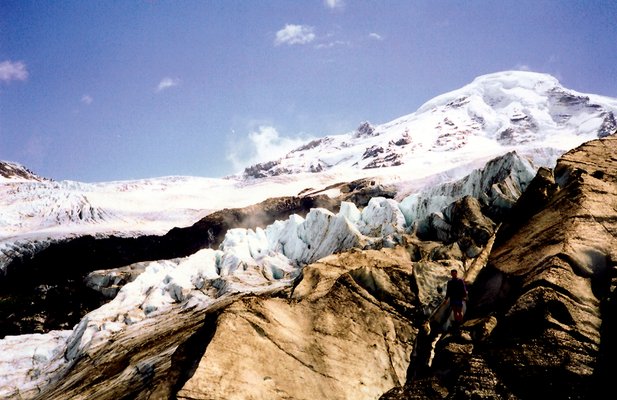
by David B. Williams Thursday, January 5, 2012

Glaciers on Washington's Mount Baker are not retreating as fast as other glaciers in the American West. Christopher M. Keane
Going, going, gone. That’s the popular view of the fate of glaciers in the American West because of climate change. But that may not be quite true. Glaciers throughout the region are shrinking, but not at the same rates. Some are actually advancing, and others have shown relatively little retreat since the 1970s. New research shows that the retreat story is not just about temperature, but ultimately about the connections between temperature, topography, precipitation and location.
This better understanding of the variables influencing how glaciers respond to climate change comes from a comprehensive study of the United States’ glaciers, not including those in Alaska, presented by Andrew Fountain, a glaciologist at Portland State University in Oregon, at the annual meeting of the American Geophysical Union in San Francisco, Calif. Fountain and his colleagues surveyed 8,303 glaciers from the Rockies to the West Coast. To identify those glaciers, Fountain and his colleagues analyzed snow and ice features depicted on U.S. Geological Survey topographic maps. To separate true glaciers from perennial snow and ice, they filtered the data for glacial mechanics, or evidence of motion.
More than 3,000 of the study’s glaciers are in Washington state, covering 450 square kilometers and accounting for 65 percent of all glaciers in the 48 continental states based on area. In addition to having the most glaciers, Washington also illustrates the complexity of glacial response. Its glaciers have generally had the lowest percentage of ice shrinkage since 1900. For example, the glaciers on Mount Rainier and Mount Baker, the two areas with the greatest number and size of glaciers, have experienced a 24 percent and 25 percent loss in area, respectively. In Montana, however, glaciers have lost 66 percent of their area. In California, glaciers lost 52 percent. “I was surprised by the variability,” Fountain says.
He attributes the differences to local topography, a factor he did not initially appreciate. Of all the glacier-veiled mountains, Mount Baker, at 3,285 meters tall, and Mount Rainier, at 4,392 meters tall, are two of the tallest mountains Fountain studied, and this made the difference, Fountain says. In general, he notes, global warming means that mountains in the American Northwest receive more rain and less snow for the same amount of precipitation. But his research has shown that on Mount Rainier and Mount Baker, enough snow is still falling at the very highest elevations to compensate for melting at lower elevations. In addition, rock falloff from the relatively weak volcanoes covers and protects the glaciers. California and Montana’s glacial-clad mountains are generally not as tall as these two, and they have less magma-generated heat to weaken them, so less rock breaks up and falls on the glaciers.
Fountain says that there is a slim silver lining to glacial retreat: More water becomes available to ecosystems. Although this may be good in the short run, he adds, in the long run, it wreaks havoc on plants and animals because when those glaciers are gone there will be an abrupt loss of water, with subsequent consequences.
“This study puts some hard data behind many ideas discussed in the glacial community,” says Erin Pettit, a glaciologist at the University of Alaska at Fairbanks. She notes that many studies have looked at how temperature change affects the snow pack and water resources, but few have focused as thoroughly on glaciers. Fountain’s study “connects larger spatial patterns and really helps to show why some glaciers are retreating and some advancing,” Pettit says. “The story is not just about climate change.”
© 2008-2021. All rights reserved. Any copying, redistribution or retransmission of any of the contents of this service without the expressed written permission of the American Geosciences Institute is expressly prohibited. Click here for all copyright requests.